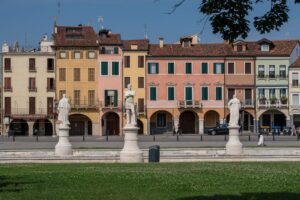There are dishes that please the palate, and there are dishes that tell a story. In Venice, castradina belongs entirely to the second category. Rich, smoky, slow-cooked and unmistakably rustic, it is the traditional food Venetians eat every year on November 21, the day dedicated to the Madonna della Salute. But castradina is more than a local specialty. It is a piece of cultural memory, a culinary ritual born from hardship and preserved through gratitude. Its aroma fills Venetian kitchens as the fog settles over the lagoon, and its flavor connects the present to one of the city’s most dramatic chapters.
To understand Venice in November, you must understand castradina. This is the complete guide: what it is, where it comes from, why Venetians eat it only once a year, and how to prepare it at home with the authentic recipe.
What Exactly Is Castradina?
Castradina is a hearty stew made from smoked, salted, and dried mutton or lamb, cooked slowly with Savoy cabbage (verza) and onions. Traditionally, the meat used is the leg or shoulder of a castrated male sheep — hence the name. Before cooking, the meat undergoes a long preservation process: it is salted, smoked, dried, and sometimes even lightly cured to intensify flavor. The result is a powerful, aromatic ingredient that transforms into tender, flavorful meat after several hours of simmering.
The broth becomes rich and almost velvety, the cabbage absorbs the smoky aromas and softens beautifully, and the dish develops a natural warmth that fits perfectly with Venice’s November weather. Castradina is rustic, deeply satisfying, and unmistakably tied to the culinary identity of the lagoon.
Why Venetians Eat Castradina on November 21
The tradition dates back to the early 1600s, during one of the most devastating plague outbreaks in Venetian history. Between 1630 and 1631, the epidemic wiped out tens of thousands of residents, and Venice faced hunger, isolation, and despair. Food supplies collapsed as the city closed its ports to prevent further infection. Only a handful of trusted trading partners were still permitted to bring goods into Venice. Among them were the Dalmatians — skilled shepherds and sailors who supplied the city with one of the few reliable preserved foods available: castradina.
The meat was salted, smoked, and dried in Dalmatia, then transported across the Adriatic Sea in a form that could last long journeys and difficult conditions. During months of plague, castradina became one of the foods that kept Venetians alive. When the plague finally ended, the Venetian Senate made a vow of gratitude to the Virgin Mary, building the Basilica della Salute and dedicating November 21 to remembrance and thanksgiving. Castradina naturally became part of that ritual, symbolizing survival, resilience, and the bonds between Venice and the communities across the Adriatic.
Since then, every year on November 21, Venetians eat castradina as a gesture of remembrance. It is not a tourist dish, not a restaurant gimmick, not an everyday food. It is a ritual. A yearly reminder of what the city endured and how it survived.
How Castradina Tastes (and Why Venetians Love It)
The flavor of castradina is unmistakable: earthy, smoky, full-bodied, with a depth of aroma that comes from the unique preservation process. After long simmering, the meat becomes tender but still structured, while the cabbage melts into the broth, adding sweetness and balance. The broth itself is rich and savory, somewhere between a rustic pot-au-feu and an ancient lagoon stew. Venetians love castradina because it tastes like November: foggy mornings, quiet calli, warm kitchens, and family gathering together.
The dish is not refined or elegant in a modern sense. It is robust, ancestral, humble and full of heart. And that is precisely why it has survived for almost 400 years.
Where You Can Eat Castradina in Venice
Most trattorie serve castradina only for a few days around November 21. The best places are family-run restaurants in Dorsoduro, Cannaregio and Castello — the neighborhoods closest to the cultural heart of the Feast of Madonna della Salute. Since many visitors now seek authentic experiences, tables often fill quickly, and locals book in advance.
If you want to pair the dish with a deeper cultural understanding, an excellent option is to explore the city’s traditions with a local expert. One of the highest-performing and best-matched options is the Explore Venice Off the Beaten Path – Orientation Tour, which brings you into real Venetian districts where Salute rituals and November flavors originate.
For a full guide to living Venice like a Venetian — especially in months full of rituals and culinary traditions — the article Venice Like a Local provides an essential cultural foundation.
And if you wish to extend the tradition with a sacred visit that complements the meaning of castradina, the easiest solution is to book a St. Mark’s Basilica ticket, one of the most popular cultural experiences for visitors interested in Venetian history and spirituality.
The Authentic Venetian Recipe for Castradina
Cooking castradina at home is both simple and slow — a reflection of its origins. Below is the traditional recipe passed down through Venetian families.
Ingredients
- 1 kg of castradina (smoked, salted lamb leg or shoulder)
- 1 large head of Savoy cabbage (verza), sliced thin
- 2 large onions, finely sliced
- 2 bay leaves
- Black peppercorns
- Extra-virgin olive oil
- Optional: a splash of white wine
- Water as needed
Preparation
1. Desalting the meat
Castradina is very salty by nature. Venetians traditionally soak it overnight in cold water, changing the water at least twice to remove excess salt.
2. First boil
Place the meat in a large pot, cover with fresh water, bring to a boil, and cook for about 20 minutes. Then discard the water. This helps soften the meat and reduces remaining salt.
3. Second cooking
Refill the pot with fresh water, add onions, bay leaves and peppercorns. Bring to a gentle simmer and cook slowly for at least 2 hours, until the meat becomes tender.
4. Adding the cabbage
Add the sliced Savoy cabbage and continue cooking for another 45 minutes to 1 hour. The cabbage should soften completely and integrate with the broth.
5. Adjusting flavors
Taste the broth before adding salt — often none is needed. A touch of olive oil or a splash of white wine can add depth.
6. Serving
Castradina is served hot, often as a complete meal. Venetians sometimes serve it in two courses: first the broth, then the meat with cabbage.
Why Castradina Still Matters Today
In a city shaped by water, time and memory, food becomes a way to keep traditions alive. Castradina matters because it honors resilience. It tells the story of a city that faced disaster and survived through community, faith and the simple act of sharing a meal. Eating castradina is not about flavor alone. It is about remembrance — for the plague victims of 1630, for the promise the city made to the Madonna della Salute, and for the enduring bond between Venice and the Adriatic world.
No matter how modern Venice becomes, castradina remains a ritual that ties each generation to the next. It is the taste of gratitude.
FAQs
Why do Venetians eat castradina only in November?
Because castradina is tied to the Feast of Madonna della Salute on November 21. It is a ritual food that commemorates Venice’s survival from the 1630 plague and honors the promise made to the Virgin Mary.
Can you find castradina in restaurants outside November?
Rarely. Most restaurants serve it only for a few days around November 21. It is not an everyday dish but a once-a-year tradition.
Is castradina difficult to cook at home?
No — it is simple but slow. The key is to soak, boil, and simmer the meat properly. What takes time develops the depth of flavor that makes the dish unique.







